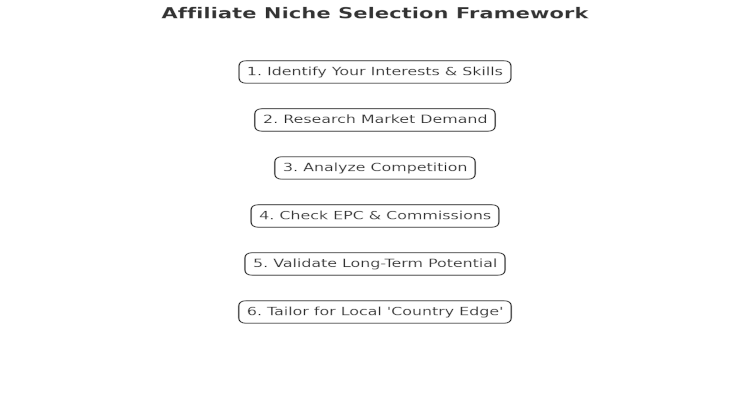
Selecting Profitable Niches: Finding Your Affiliate Country Edge (Article: 2 of 25 )
If affiliate marketing is a game, then your niche is the playing field. Pick the wrong field, and you’ll be running uphill in the rain. Pick the right one, and suddenly every play feels like you’re coasting downhill with the wind at your back.
Niche selection is one of the most underestimated parts of building an affiliate business. People often think, “I’ll just sell what’s trending,” or “Everyone’s doing tech, so I will too.” But here’s the truth: profitable niches aren’t just about popularity, they’re about finding the sweet spot where your audience, your offer, and your market conditions all align.
And if you want to stand out in your own country or region, there’s an even bigger opportunity: finding your “country edge” a niche that’s not only profitable globally, but also perfectly tailored to local trends, habits, and needs.
Why Niche Selection Matters
Let’s start with a mental image: Imagine setting up a coffee cart. You could place it on a quiet street corner where only three people pass by every hour, or you could put it right outside a busy train station at 8 a.m. Which would you choose?
Affiliate niches work the same way. A niche with strong demand, limited competition, and healthy commissions is your busy train station. A bad niche is your quiet street corner.
Here’s why niche selection can make or break your business:
-
It determines your audience size and quality. You could promote the best product in the world, but if your audience is too small or uninterested, you won’t make sales.
-
It impacts your competition level. Entering a niche with 500 established websites can be like showing up to a marathon that’s already been running for two hours. You can still run, but good luck catching up.
-
It affects your earning potential. A niche with low commissions means you’ll have to work harder for every dollar. A niche with higher payouts can make your efforts far more rewarding.
-
It shapes your content and branding. Your niche influences your voice, tone, and the kind of authority you’ll build.
In other words, your niche isn’t just a product category, it’s the foundation of your affiliate empire.
Market Research: Tools and Techniques
Before you pick a niche, you need to research it like a detective who just got handed a mysterious case file. The good news? The internet is overflowing with free and paid tools to help you crack the code.
Here are some of the best:
1. Google Trends
Type in your niche idea and see if it’s trending upward, stable, or falling off a cliff. For example, “home fitness equipment” saw a spike in 2020, but some categories have since normalized. A slow, steady climb is often better than a short-lived peak.
2. Keyword Research Tools
Platforms like Ahrefs, SEMrush, or Ubersuggest can show you:
-
Search volume
-
Keyword difficulty
-
Related keywords
-
Seasonal trends
Pro tip: Look for keywords with moderate competition but steady monthly searches. If the keyword is too easy, the niche may be too small. Too competitive, and you’ll be fighting digital gladiators.
3. Affiliate Networks
Sites like ShareASale, CJ Affiliate, and ClickBank list thousands of programs. Search by category and sort by EPC (Earnings Per Click) or average commission to get a sense of profitability.
4. Social Media Listening
Platforms like BuzzSumo or even TikTok’s search can show you what’s trending socially. If you see a flood of posts and engagement in a niche, it’s a sign of high audience interest.
Analyzing Competition vs. Demand
Here’s where a lot of affiliate marketers trip up, they think a niche with high demand is automatically good. But high demand without considering competition is like joining a gold rush 10 years late; all the easy gold is gone.
Here’s how to balance the two:
-
High Demand + Low Competition: Jackpot. This is your ideal scenario.
-
High Demand + High Competition: Possible if you have a unique twist or brand.
-
Low Demand + Low Competition: You might rank easily, but sales could be slow.
-
Low Demand + High Competition: Run. Far. Away.
Example: Let’s say you’re eyeing the “organic pet food” niche in your country. If your keyword research shows 10,000 monthly searches but only a handful of well-optimized blogs and few social media influencers, you may have found a sweet spot.
Estimating EPC and Average Commissions
EPC (Earnings Per Click) is one of the most overlooked metrics when picking a niche. It’s the average amount you earn each time someone clicks your affiliate link. If you have 1,000 clicks a month, an EPC of $1 means $1,000 monthly revenue.
How to check EPC:
-
Most affiliate networks list EPC for their programs.
-
EPC can vary wildly by product type and region.
Average commissions:
Physical products often pay 4 - 10%, while digital products and online courses can pay 30 - 70%. For example:
-
Selling a $40 kitchen gadget at 5% commission nets you $2 per sale.
-
Selling a $200 online course at 50% commission nets you $100 per sale.
When evaluating niches, think about the work-to-reward ratio. Sometimes, a smaller audience with higher-value products beats a massive audience with low-margin products.
Validating Long-Term Potential
The internet is a fast-moving river. If you jump into a niche that’s just a fad, you might ride a wave for a few months, then find yourself standing in ankle-deep water wondering where everyone went.
Here’s how to check for staying power:
-
Historical Data: Use Google Trends to look at 5–10 years of data. A healthy niche has stable or gently rising interest.
-
Evergreen Needs: Does your niche solve a problem people will always have? For example, “weight loss” will never go out of style, but “fidget spinners” came and went.
-
Adaptability: Can the niche evolve? Tech niches that adapt to new products and features often last longer than one-hit wonders.
-
Local Relevance: If you’re aiming for a “country edge,” make sure the niche isn’t dependent on a temporary local trend. For example, promoting winter gear in a country where winters are mild may limit your reach.
Wrapping It Up
Selecting a profitable niche isn’t about guessing it’s about informed decision-making. The magic formula is: Strong demand + Manageable competition + Solid commissions + Long-term relevance.
And when you add your “country edge,” you can carve out a space that’s yours alone, tapping into cultural nuances, local buying habits, and unique market gaps that global competitors may overlook.
Your niche is the stage. Choose wisely, and you won’t just play the game you’ll own it.
Photorealistic Image Alt Text: A person working at a laptop surrounded by charts, graphs, and market research tools, representing niche selection in affiliate marketing.
High-Authority External Links:

